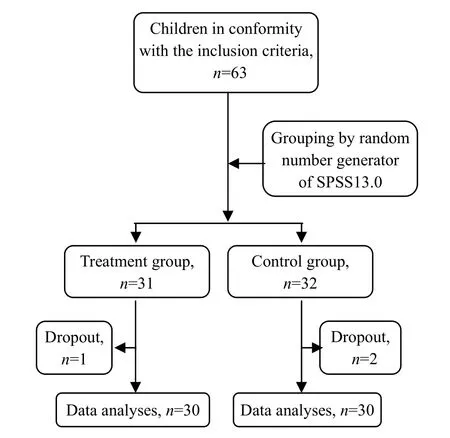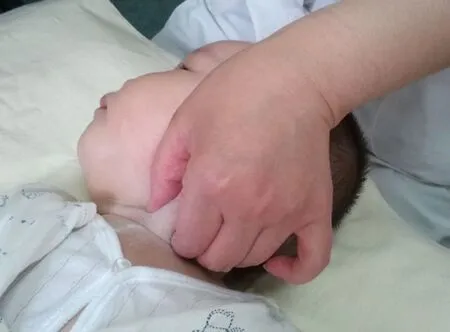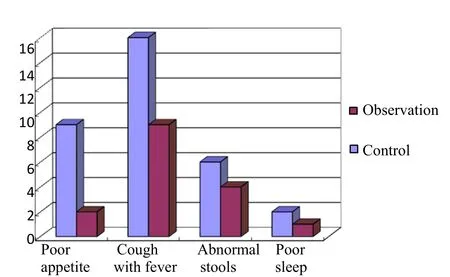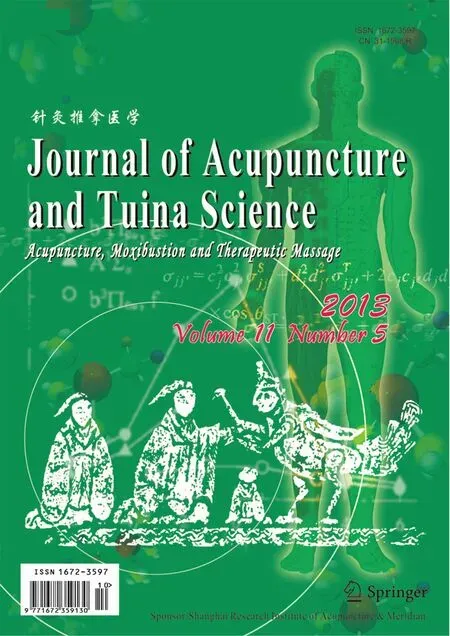Clinical Observation on Tuina Therapy for Congenital Muscular Torticollis
2013-07-18WangQianChenZhiwei
Wang Qian, Chen Zhi-wei
1 Acupuncture and Tuina College, Shanghai University of Traditional Chinese Medicine, Shanghai 201203, China
2 Tuina Department, Yueyang Hospital of Integrated Traditional Chinese and Western Medicine Affiliated to Shanghai University of Traditional Chinese Medicine, Shanghai 200437, China
Clinical Observation on Tuina Therapy for Congenital Muscular Torticollis
Wang Qian1, Chen Zhi-wei2
1 Acupuncture and Tuina College, Shanghai University of Traditional Chinese Medicine, Shanghai 201203, China
2 Tuina Department, Yueyang Hospital of Integrated Traditional Chinese and Western Medicine Affiliated to Shanghai University of Traditional Chinese Medicine, Shanghai 200437, China
Objective: To observe the clinical effect of spleen-strengthening and kidney-benefiting tuina therapy for congenital muscular torticollis.
Methods: A total of 63 cases who met the inclusion criteria were randomly allocated into an observation group and a control group. Cases in the control group were treated with tuina manipulation on the local area, whereas cases in the observation group were treated with local tuina plus manipulation that acts to strengthen the spleen and benefit the kidney. Cases in both groups were treated three times a week, 20 times for a course of treatment. The clinical effects were observed after three courses.
Results: There was no between-group significant difference in the total effective rate. However, the recovery and marked effect rate in the observation group was 63.3%, versus 33.3% in the control group, showing a significant difference (P<0.05).
Conclusion: Combining local tuina with spleen-strengthening and kidneybenefiting tuina manipulation could obtain better effect in congenital muscular torticollis than local tuina alone.
Tuina; Massage; Congenital Torticollis; Infant
Congenital muscular torticollis (CMT) is a common condition in pediatric orthopedics department. It is usually discovered at birth or develops months after. In congenital torticollis, the sternocleidomastoid muscle is tight and shortened, resulting in the following symptoms: the head tilting to one side with difficulty turning the head, a palpable soft lump in the affected neck muscle; limited range of motion in the neck; flattened face on one side, and asymmetrical oculi rimae. Without timely treatment, CMT may have negative impact on the infant’s wellness.
Tuina therapy has exact effect for CMT. Despite the overall effect of tuina over the affected area that aims to relax muscles, resolve lumps and unblock collaterals, it requires a long period of time and makes it hard for infants to stick with the treatment. Based on the holistic view and pattern identification in Chinese medicine, we’ve added spleen-strengthening and kidney-benefiting manipulation to local tuina therapy and observed its clinical effect.
1 Clinical Materials
1.1 Diagnostic criteria
This was made according to the diagnostic criteria for CMT in theShanghai Diagnostic and Therapeutic Guidelines of Traditional Chinese Medicine[1].
Major symptoms include the head and neck tilting to the affected side and rotating towards the healthy side; tightness or a soft lump on the sternocleidomastoid muscle of the affected side; limited range of motion of the neck; smaller face or oculi rima on the affected side, flattened occiput on the healthy side and compensatory scoliosis of thoracic vertebrae; and thickening of the sternocleidomastoid muscle on the affected side, a muscular lump, echo enhancement or reduction and rough, thickened muscle texture showed in an ultrasound examination.
1.2 Inclusion criteria
Those who met the above criteria; younger than 1 year old; never received other therapies for CMT; and the legal guardians of the infant were willing to participate in this trial and signed the informed consent.
1.3 Exclusion criteria
Those who failed to meet the above inclusion criteria; osseous torticollis due to spinal malformation, compensatory postural torticollis due to visual disturbance and neurogenic torticollis due to paralysis of neck muscle; those who received other therapies concurrently during the treatment; having complications of severe primary conditions in cardio-cerebrovascular, liver, kidney and hematopoietic systems; an allergic constitution or severe lesion, infection on the affected area; and those who were reluctant to participate in this trial.
1.4 General data
A total of 63 cases were treated in Pediatric Tuina Outpatient, Yueyang Hospital of Integrated Traditional Chinese and Western Medicine Affiliated to Shanghai University of Traditional Chinese Medicine between May 2012 and April 2013. The youngest infant was 15 d, the oldest was 9 months, with a mean age of 61.5 d. These babies were randomly allocated into an observation group of 32 cases and a control group of 31 cases by the number generated by the SPSS 13.0 version software. Before treatment, there were no between-group significant differences in general data (P>0.05), showing that the two groups were comparable (table 1). The clinical procedures were shown in Fig.1.

Table 1. Between-group comparison of general data
2 Treatment Methods
2.1 Pre-treatment preparation
Placed the infant to a supine position (no pillow) and sat to the side of the infant’s head. Prepared some talc powder for medium use.

Fig.1 Clinical procedures in the two groups
2.2 Treatment principle
As for the control group, the principle of treatment was to relax muscles/tendons, soften lumps and resolve swelling. As for the observation group, the principle of tonifying the spleen and kidney was added.
2.3 Observation group
2.3.1 Conventional tuina therapy
An-Pressing, Rou-Kneading and Tanbo-Plucking manipulation: Applied Rou-Kneading along the origin and insertion of the sternocleidomastoid muscle back and forth using the thumb, middle and ring fingers, and followed with gentle muscle plucking. Eight minutes of An-Pressing, Rou-Kneading and Tanbo-Plucking were applied alternately at the frequency of 100-120 times per minute (Fig.2).

Fig.2 An-Pressing and Rou-Kneading manipulations
Na-Grasping and Nie-Pinching manipulations: Applied 2 min of Na-Grasping and Nie-Pinching to the sternocleidomastoid muscle on the affected side using the thumb, index and middle fingers, at the frequency of 100-120 times per minute. It’s advisable to gradually increase the force up to the infant’s tolerance (Fig.3).

Fig.3 Na-Grasping and Nie-Pinching manipulations
Passive extension: Held the shoulder of the affected side with one hand and supported the vertex with the other hand; pushed the infant’s head slowly towards the healthy side, allowing for a passive side-to-side movement of the head in a frontal plane. Then then held the occiput of the affected side with one hand and supported the lower mandible of the healthy side with the other hand; made the infant’s head stay in the vertical axis and performed soft passive rotation towards the affected side to gradually stretch the sternocleidomastoid muscle on the affected side. Repeated 20 times of each and conducted approximately 1-minute long passive extension every five times of brief extensions (Fig.4).
2.3.2 Spleen-strengthening and kidney-benefiting tuina therapy
This included 300 times of tonifying the Pijing (on the thumb), Shenjing (palmar aspect of the little finger) respectively, 50 times of An-Pressing and Rou-Kneading Pishu (BL 20) and Shenshu (BL 23) respectively, 5 times of Nie-Pinching the spine and finally 10 times of Ca-Rubbing the spine[2-4].
The infants were treated three times a week, 20 times for a course of treatment. The therapeutic efficacy was observed after three courses of treatment.

Fig.4 Passive extension manipulation
2.4 Control group
Conventional tuina therapy alone was employed in the control group and the time and course of treatment were same as the observation group.
3 Therapeutic Efficacy Observation
3.1 Criteria of therapeutic efficacy
This was made according to the criteria of therapeutic efficacy for CMT in theShanghai Diagnostic and Therapeutic Guidelines of Traditional Chinese Medicine[1]and the symptom grading scale for CMT. The decrement rates of symptom scores were calculated using the Nimodipine formula (table 2).
Symptom decrement rate = (Pre-treatment symptom score – Post-treatment symptom score) ÷ Pre-treatment symptom score × 100%.
Recovery: A neutral position of the infant’s head, absence of abnormality or lump, flexible neck movement and the symptom decrement rate ≥90%.
Marked effect: Substantial improvement of traditional Chinese medicine (TCM) signs and symptoms, the symptom decrement rate ≥70% but<90%.
Improvement: Alleviated TCM signs and symptoms, the symptom decrement rate ≥30% but <70%.
Failure: The TCM signs and symptoms remain unchanged and the symptom decrement rate <30%.
3.2 Treatment results
3.2.1 Comparison of clinical effects
Recovery and marked effect rate = (Recovery cases + Marked effect cases) ÷ Number of the cases in the group × 100%.
After three months of treatment, the recovery and marked effect rate and total effective rate in the observation group were 63.3% and 93.3% respectively, versus 33.3% and 90.0% in the control group, showing a statistical significance (P<0.05) in recovery and marked effective rate but no statistical significance in the total effective rate. This indicates that both methods had remarkable effects for CMT (table 3).
3.2.2 Comparison of the infants’ overall health
During the treatment, the incidence of major symptoms including poor appetite, coughing with fever, abnormal bowel movements and poor sleep were significantly lower than that in the control group (Fig.5). This indicates that, as a holistic therapy, the spleenstrengthening and kidney-benefiting manipulation could improve the infants’ spleen and stomach functions, reinforce their constitutions and help with their healthy growth and development.

Table 2 . TCM symptom grading scale for CMT

Table 3. Between-group comparison of clinical effects (case)

Fig.5 Between-group comparison of infants’ overall health
4 Discussion
CMT affects approximately 0.4%-1.3% of the infants[5]. Its etiology is still unclear yet in modern medicine. It’s believed to be associated with resistance to venous return or hematoma due to birth injuries of the sternocleidomastoid muscle. In addition, developmental defect of the sternocleidomastoid muscle in embryonic phase congenital and genetic predisposition may also play a role[6-7].
In Chinese medicine, CMT falls under the category of muscular spasm or muscular nodules[3]. It often occurs as a result of qi stagnation and blood stasis, which further lead to blockage of vessels and malnourishment of the local muscles and tendons. Consequently this condition is often treated with methods to relax muscles, circulate blood, resolve lumps, soften hard nodules and eliminate swelling. Chinese medicine holds that the kidney is our congenital base and spleen is the acquired one. The spleen and kidney of infants are often tender and not strong enough. Considering from the holistic view and pattern identification in Chinese medicine, we used this‘spleen-strengthening and kidney-benefiting manipulation’ to regulate the infants’ congenital and acquired bases. Regarding the specific pediatric tuina points, Pijing (on the thumb), Shenjing (palmar aspect of the little finger), Pishu (BL 20) and Shenshu (BL 23) can help to generate qi and blood, nourish muscles and tendons and relieve spasm. Nie-Pinching the spine and Ca-Rubbing manipulation on the Governor Vessel can balance yin and yang, harmonize the Zang-fu organs, supplement Yuan-Primary qi, strengthen the spleen and stomach, unblock meridians and circulate qi and blood. In terms of modern anatomy, Pishu (BL 20) andShenshu (BL 23) are located near the erector muscle of the spine. An-Pressing and Rou-Kneading these two acupoints can work on the erector muscle. Additionally, Nie-Pinching the spine and Ca-Rubbing manipulation along the spine can stimulate the entire back muscle group. This can, in a way, help to maintain a balanced posture of the head and normal movements[8-12].
Judging from the therapeutic efficacy analysis, there was no significant difference in the total effective rate between ‘spleen-strengthening and kidney-benefiting’and conventional tuina therapy; however the recovery and marked effect rate in the observation group was remarkably higher than that in the control group (P<0.05). Furthermore, major symptoms such as poor appetite, coughing with fever, abnormal bowel movements and poor sleep in the observation group were markedly less than that in the control group. It can therefore be concluded that ‘spleen-strengthening and kidney-benefiting tuina method’ can strengthen the spleen and stomach and improve the infants’constitution. It is an effective pain-free green therapy for CMT and worthy of being popularized in clinical treatment.

[1] Shanghai Municipal Health Bureau. Shanghai Diagnostic and Therapeutic Guidelines of Traditional Chinese Medicine. 2nd Edition. Shanghai: Publishing House of Shanghai University of Traditional Chinese Medicine, 2003: 442.
[2] Liu ZH, Cen LT. Effect of tuina on neurodevelopment in premature infants with brain injury. J Acupunct Tuina Sci, 2013, 11(1): 7-12.
[3] Yu HH. Tuina treatment for infantile torticollis. Zhejiang Zhongyi Xueyuan Xuebao, 2005, 29(6): 71.
[4] Shen YJ, Chen ZW, Jin YC. Curative effect observation on tuina therapy for spleen-deficiency infantile diarrhea. J Acupunct Tuina Sci, 2013, 11(1): 26-30.
[5] Shi CR. Special therapeutic techniques in pediatric surgery. Beijing: Scientific and Technical Documents Publishing House, 2004: 708-711.
[6] Zhu ZQ, Lǚ CY. Clinical study advance in non-surgical infantile torticollis. Yunnan Zhongyi Zhongyao Zazhi, 2010, 31(12): 69-71.
[7] Xie BS, Jodge, Jiang ZQ, Xie M. Research for the reason of congenital muscular torticollis (CMT). Linchuang Xiaoer Waike Zazhi, 2002, 1(2): 118-122.
[8] Luo W, Huang LH. Electrogastrographic change after acupuncture and massotherapy in 50 children with chronic superficial gastritis. Shanghai Zhenjiu Zazhi, 2007, 26(5): 5-6.
[9] Zhou WX. Acupuncture and Tuina Therapeutics. Shanghai: Shanghai Scientific and Technical Publishers, 2001: 200.
[10] Xu LB, He YN. The effect of Du Meridian-regulating therapy on immunoglobulin in cervical intervertebral disc herniation. Shanghai Zhenjiu Zazhi, 2011, 30(9): 615-616.
[11] Xu XH. Mechanism and research advance in infantile spine-pinching therapy. Zhongguo Minjian Liaofa, 2010, 18(5): 73-74.
[12] Chen LC. Observations on the efficacy of rapid needling plus massage in treating infantile diarrhea. Shanghai Zhenjiu Zazhi, 2011, 30(7): 447-449.
Translator: Han Chou-ping
R244.1
A
Date: June 5, 2013
Author: Wang Qian, M.M., resident
Chen Zhi-wei, M.M., associate chief physician.
E-mail: chenaw2005@163.com
杂志排行
Journal of Acupuncture and Tuina Science的其它文章
- Clinical Observation on Acupuncture Plus Acupoint Sticking for Bronchial Asthma in Remissive State
- Observation on Clinical Effect of Superficial Needling for Intractable Humeral Epicondylitis
- Therapeutic Efficacy Observation on Point-toward-point Acupuncture Combined with Herbs Iontophoresis for Knee Osteoarthritis
- Therapeutic Efficacy Observation on Combining Acupuncture, Tuina and Functional Exercise for Transverse Process Syndrome of the Third Lumbar Vertebra
- Therapeutic Efficacy Observation on Combining Acupuncture and Chinese Herbal Fumigation for Cervical Radiculopathy
- Clinical Observation on Dong’s Extraordinary Points for Tinnitus Due to Cervical Spondylosis
